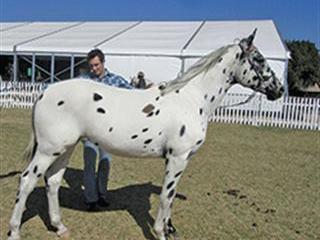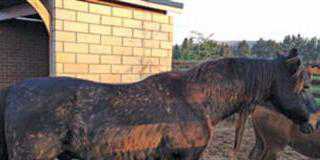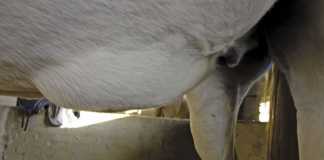
The colour genetics of Appaloosa horses is fascinating. Genes are made up of two alleles (partners), each of which can be dominant or recessive. A dominant gene or allele is written in capital letters – ‘E’ or ‘LP’, for example – while a recessive gene is written in lower case letters (‘e’ or ‘lp’). Each animal has two sets of alleles, and the genetic make-up, using gene ‘e’ as an example, could be ‘EE’, ‘Ee’ or ‘ee’.
The least complicated genetics are for a solid chestnut horse with no white markings, which would be ‘ee’. This is called a ‘solid’, ‘base’ or ‘background’ colour. By contrast, all Appaloosa variations are based on a solid colour combined with a pattern that includes white genes, dilution genes (such as roaning) and pattern genes (spots). White markings are areas of the coat where the base colour is absent.
A chestnut horse (ee) with a splash gene would have a wide white stripe down the middle of its face (blaze) and four white feet and a splash on the belly. However, the amount of white isn’t entirely genetic. Clones made of the Quarter Horse Smart Little Lena all had different-shaped blazes, even though their genetic make-up was identical. Something in the womb of the mare carrying the clone was different and therefore the white markings developed differently.
Leopard spots
Of the various dilution genes, the one most often seen in Appaloosas is the classic roan gene, where the hairs become partially white. Alternatively, in a horse where the base colour is chestnut, the gene will result in a pink body, with darker chestnut legs and face.The gene for spots, which makes an Appaloosa different from any other breed of horse, is the ‘leopard gene’ (LP). This results in mottled skin and corresponding hair.
The spots are easily seen on the muzzle, around the eyes and eyelids and under the tail. These spots are usually in the base-coat colour. So a chestnut leopard spot Appaloosa would be a white horse with chestnut spots and striped hooves. If it also has the splash gene it will have a blaze, white socks and pinkish hooves. Combine this with roaning and it will have pinkish spots on its body with a darker chestnut face.
Pattern types
Each Appaloosa pattern has a specific name, and a horse can have more than one pattern. A spot can be in the base colour on a white coat, or white on a darker base, for example. A ‘blanket’ or ‘snowcap’ is usually seen as a large white patch over the hindquarters of a bay or chestnut and spots on the blanket are usually in the base colour. ‘Fewspot’ means exactly that – a white horse with very few leopard spots, usually around the flank, head and neck. ‘Snowflake’ refers to white flecks on a dark body, while the terms ‘roaning’ and ‘marble’ refer to horses that have both the Appaloosa and roaning genes.
Appaloosa breeders must find it very exciting to wait for a foal. With such a large variety of ‘spotty genes’ it’s almost impossible to predict what you’ll get. Foals also change colour as they grow older, so the colour at birth may not be the final one. Perhaps this element of surprise is what makes Appaloosas such a popular breed.
Contact Dr Mac at [email protected]. Please state ‘Horse talk’ in the subject line of your email.













